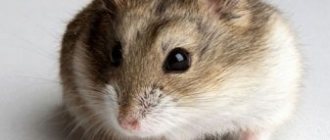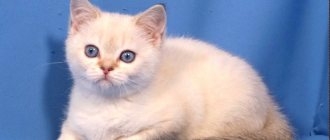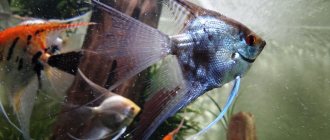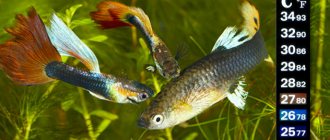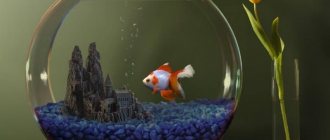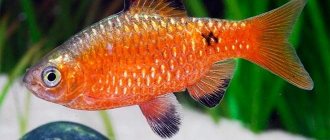Description of the platie
Classification and parameters of water for comfortable maintenance:
- Latin name : Xiphophorus maculatus.
- Comfortable water temperature: 24-27 degrees.
- Acidity pH: 7,5-8.
- Rigidity: 8-25.
- Aggressiveness: Not aggressive.
- Content difficulty: Easy.
Pecilia is a bright, beautiful small-sized live-bearing fish. Its body length ranges from 3.5 cm to 5 cm. In an aquarium under good conditions it lives for 3-4 years. Body color can vary; it is impossible to tell about all the available colors. I would just like to say about the disk platie, which is also called the platie balloon. This species was specially bred. Fish of this species have a curved spine and deformed internal organs. Because of this, they are more picky about their contents than ordinary platies.
Photo: male with a smooth belly
Types of platies
Aquarium platie fish include 33 subspecies, not counting hybrid varieties. All representatives differ in color, body shape and fins, and even behavior, but thirteen subspecies are the most popular and famous.
Balloon
Pecilia balloon is one of the most interesting species of the genus. A distinctive feature of the phenotype is a curved spine, which is why the fish has a short body, similar to a barrel. This body structure has a negative impact on the body of individuals, so cylinders often develop health problems.
Balloon fish can grow up to 12 cm in length, but most often the size does not exceed 10 cm. The color of the scales can be of different colors and shades. The maintenance and care of this species requires a lot of attention due to the curved spine, otherwise the pet will die. If the maintenance conditions are met, the cylinders last 2–4 years.
Radish
Pecilia radish is a fish with a funny name, bred thanks to breeders. A distinctive feature is the uniquely shaped rear fin, which is jet black in color. Other fins also have a dark background. The body of the radish can be scarlet or other colors.
The variety is distinguished by good health and endurance, so its maintenance will not cause much trouble to the owner.
Black
Black platylia is a peaceful and calm variety that loves activity and movement. The body of the fish is covered with black scales, which shimmer beautifully in the rays of light. The tail fin and head are orange or scarlet, the dorsal fin is translucent, with a bluish tint. The phenotype grows up to 10 cm in length, the female is usually larger than the male.
Black platies readily and easily interbreed with other subspecies of the genus, resulting in fish with a unique color.
Tricolor
The tricolor variety grows up to 7 cm in length and requires a space of at least 40 liters. The keeping of this platie is simple, but the species requires the planting of abundant living vegetation, where the fish can feel safety and privacy.
The color of the southern resident is multicolored, there are several options: yellow with green and blue, different combinations of dark, orange and yellow tones.
To make the color of the fish brighter and more saturated, live food is introduced into the diet.
Sailing velifera
The high-finned sailfin platie gets its name from its large dorsal fin, which looks like a sail. The length of the phenotype grows from 4 to 10 cm. The color of the fish can be of different tones: chocolate, silver, spotted, yellow. In the aquarium it lives in the middle layers and is active and mobile. If the velifera lies on the bottom, it means that something is wrong with the pet.
Spotted
The spotted variety is closest to the wild species of platies, both in color and size. The fish grow up to 6 cm in length, the main background of the body is orange, with dark spots and a caudal fin. Breeders prefer to breed spotted representatives, obtaining many different fish with bright colors.
To keep spotted platies, you need a tank with a minimum volume of 60 liters, since the phenotype loves space and movement.
Disk
Disc platies got their name because of the unusual shape of the body - in the form of a disk. You can distinguish a female from a male by size: the females are much larger than the boys. The disc platy has an interesting defect: the fish have a curved spine, while in newborn platy fry it is straight, but as they grow older it becomes deformed. Because of this feature, the phenotype requires more attention and care than other varieties.
Yellow
The yellow fish is distinguished by its bright, rich color the color of the sun, while its fins are painted in scarlet shades and are transparent at the ends. Pets grow up to 10 cm in length. Males are much smaller than females, and are distinguished by a more saturated color of the caudal fin. Sunfish do not require special housing conditions, the phenotype is unpretentious and has funny behavior.
Neon
Pecilia neon (rainbow) is a fish with an amazing body color: its scales shimmer with blue and light blue colors, which change reflections when exposed to sunlight. The caudal fin and the bases of other fins are usually dark in color. Neon rainbow fish prefer a schooling lifestyle, so they need to be populated in a group - at least 6-8 fish.
Black-tailed
The red black-tailed platyea resembles swordtails in appearance, and is the ancestor of many varieties of platies. The caudal fin of the phenotype is jet black, and the body is bright red or yellow. To prevent pets from losing the richness of their tones, experienced aquarists recommend feeding the fish with live food. Black-tailed platies reach 12 cm in length and are active and energetic.
Mickey Mouse
The Mickey Mouse platie has acquired an interesting name due to its color: at the tip of the fish’s caudal fin there are dark spots, shaped like the muzzle of a cartoon mouse. The body of the Mickey Mouse platie can be orange or silver, the ventral fins are transparent, and the dorsal fins are yellow. This species leads a school life, so it is better to populate one aquarium with six or seven fish at once.
Sunset
Pecilia Sunset (calico) is a rather rare variety. The color of the fish stretches from the head to the caudal fin, changing color from yellow to bright scarlet. There are dark spots on the sides of the phenotype, the fins are yellow-red with a black border along the edges. Males have richer and richer tones, while girls have slightly darker colors.
Tuxedo
Pecilia tuxedo is a blue aquarium fish that is distinguished by its beautiful appearance and friendly character. The back and belly of the phenotype are silvery, and the sides have a blue tint. Pets grow up to 10 cm in length.
Tuxedo is often crossed with other varieties because the result is a fish with pleasing and unusual colors.
Classification of platies
There are many types of platies, many of them are listed in the photo. So, we list some types below:
|
|
Reproduction
Platies reproduce very easily both in a common reservoir and in a nursery. But if you plan to get full-fledged offspring, then the latter should be given preference.
Sexual maturity in this species is reached at 8-12 months.
Sexual differences are pronounced - males are much smaller than females and have a special gonopodium organ, this is a modified anal fin that resembles a small tube in appearance. Their scales become especially bright during the rutting period.
Females are much larger and have less pronounced coloring. During pregnancy, the abdomen increases significantly in size, and a characteristic dark spot appears near the anal fin - it is inherent in all viviparous fish, so the eyes are first formed in the fry, and they are visible through the thin tissue of the peritoneum. In the first birth, about 20 cubs are born, in subsequent births - up to 50.
You can use a three-liter jar or a small aquarium as a spawning tank; it is planted with plants and shaded. As soon as the female shows signs of pregnancy, she must be removed. In 1.5-2 months the fry will be born.
The mother is immediately removed, and the cubs are independent from the first hours of life. Initially, they can be fed with boiled egg yolk mixed with Artemia nauplii, dry flakes diluted with water.
When using live food, the fry grow very quickly.
Just like all viviparous mothers, from 1.5-2 months of life, babies are regularly sorted by sex and separated.
In what conditions should it be kept and how to care for it?
Aquariums from 40 liters are suitable for keeping platies; if the volume is larger, then this is even better. The fish do not fight among themselves, unless of course the female is in the last days of pregnancy and can be aggressive towards males. They are kept with a predominance of females. For example, 1 male and 2-3 females.
Every week you must change 20% of the water. For a comfortable existence in the aquarium, you should install a filter and an aerator.
Photo: gets along well with catfish
Conditions and care
Platies do not require much attention and effort in maintenance. However, to keep the fish happy and healthy, some points should be adhered to.
The composition of the water in the aquarium is not critical. The temperature should be maintained within 22-27 degrees. The water should be fresh, 1/3 of the liquid should be changed once a week. The acidity (pH) of water is from 7.5 to 8, the hardness (dGH) is average, from 8 to 25. The fish will feel more comfortable in salted water: 1-2 teaspoons per 10 liters of water.
We recommend reading
How to breed gourami at home
The volume of fish “housing” is 50 liters per flock. A couple will easily take root in a 5-liter jar. Flocks consist of 7-11 individuals.
Platies are active and mobile. It is necessary to take this point into account when arranging an aquarium.
It is important to monitor the water temperature. Too low threatens colds in fish, the appearance of fin rot and fungus. Therefore, it is important to keep the temperature in the aquarium under control. It is advisable to create aeration. In addition, fish need glass covering the top of the aquarium, or a lid - active fish can jump out.
How to distinguish a male from a female
If you look closely at the fish, you will notice that females have a rounded abdomen, a duller color and are larger in size than males. Another distinctive feature is the presence of a pointed small anal fin in the male, the so-called gonopodium. The anal fin of the female is wide, as in the photo below:
Photo: female platie in the last stages of pregnancy
Compatibility with other fish
As a rule, these fish get excellent company with representatives of related species. In addition, if you populate an aquarium with platies of various species, they can form pairs and reproduce offspring that have new characteristics that are distinctive from other varieties.
Thanks to this feature, even a beginner in the world of aquarium business can turn into a breeder. True, one should not lose vigilance, otherwise the original fry will not be given life by their voracious neighbors. But this property also has a reverse, negative side: males can turn from good comrades into rivals, and the mating season will be accompanied by very severe conflicts.
Another nuance is that platies suffer from cannibalism and can eat their own and their neighbors’ offspring. Therefore, you should take care of a separate tank if the goal is to obtain and raise a litter of new fish. Basically, these fish coexist well with other small inhabitants, peace-loving and non-conflict.
Don't forget about climate preferences. It is not worth settling platies with lovers of warmer or colder waters, the same applies to hardness and acidity. The owner has a choice, since their little charges get along with many aquatic brothers:
- iris;
- scalars;
- guppy;
- zebrafish;
- tetras;
- labeo;
- swordtails;
- cockerels;
- mollies;
- catfish-corridors;
- plecostomus catfish;
- boots;
- discus;
- macropods;
- blue, gold, marble gouramis;
- barbs - Sumatran and bream-like.
These babies do not have such a good relationship with larger, restless, predatory aquarium inhabitants. Eels are also not the best company for them. The following fish are not at all suitable for living in the same tank with platies:
- goldfish;
- cichlids – African and South American;
- large barbs – arulius, crosses, etc.;
- Koi carp;
- mosque mouths;
- astronotuses;
- snakeheads.
If the owner wants to have a well-organized aquatic community where peace and harmony reign, it is worth carefully selecting its inhabitants.
Fish reproduction
The main condition for breeding platies is the presence of a male and a female in the aquarium. In general, it is better if there is 1 male and 3 females. Thanks to this, the females will be able to take a break from the attention of the male, who is constantly pursuing them. Platies are viviparous. Immediately after birth, the fry can swim and feed; in order for it to survive, it needs shelter.
You can tell if a female is pregnant by a large round belly and a dark spot near the anal fin. Fry can be born every 28 days. During one birth, from 20 to 40 babies are born. To preserve the offspring, the fish should be placed in a separate tank and hornwort should be placed there. After giving birth, the mother must be removed from the fry, otherwise she will eat them.
Caring for babies is easier than ever, since they are already formed. They are fed dry food ground into dust several times a day. With good nutrition, the fish becomes an adult after 3 months.
Habitat of platies in the natural environment
Several species of fish from the carp-toothed family are considered platies. They are bred by both experienced aquarists and beginners. They are often confused with mollies, although these aquarium inhabitants are a variety of them.
The homeland of platies is the regions of Guatemala and Southern Mexico, but today these fish can be found in almost every corner of the planet. They were first bred in Europe in 1907, and almost immediately the breed gained worldwide popularity. Wild platies can be found in the lower reaches of rivers that flow into the waters of the Atlantic Ocean. Individuals living in nature are not as brightly colored as their “domesticated” counterparts.
The main species of aquarium representatives are the southern platy, spotted platy and swordtail. Breeders actively crossed platies with swordtails, so their offspring are quite difficult to identify. Usually, if a fish has a sword-shaped appendage, it means it is a male swordtail, and all other fish, including female swordtails, that do not have this feature, are classified as platies.
The southern highfin platy was first mentioned at the end of the 19th century, the spotted platy in 1904, and the green swordtail only in the 30s. Breeders became interested in these cute fish, and thanks to interspecific crossings, many subspecies of platies appeared. Moreover, you can cross almost any representative of the species.
Spotted platies are often used in work. It was she who became the founder of many breed species with natural colors. But the green swordtail has not been studied so well, and meeting this fish is very rare. It attracts the attention of breeders and, having obtained such a fish, they cross it with swordtails and platies to obtain aquarium fish with an unusual color.
